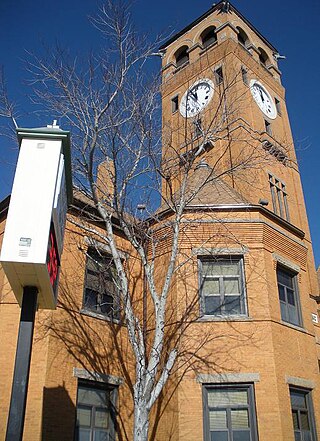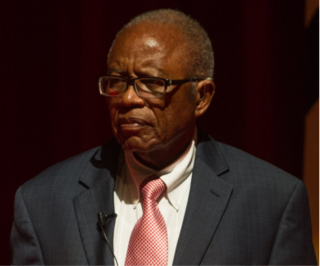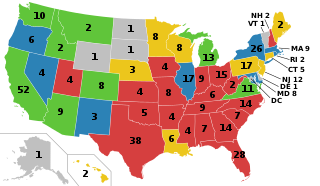
The Fifteenth Amendment to the United States Constitution prohibits the federal government and each state from denying or abridging a citizen's right to vote "on account of race, color, or previous condition of servitude." It was ratified on February 3, 1870, as the third and last of the Reconstruction Amendments.

Tuskegee is a city in Macon County, Alabama, United States. General Thomas Simpson Woodward, a Creek War veteran under Andrew Jackson, laid out the city and founded it in 1833. It became the county seat in the same year and it was incorporated in 1843. It is the most populous city in Macon County. At the 2020 census the population was 9,395, down from 9,865 in 2010 and 11,846 in 2000.
Baker v. Carr, 369 U.S. 186 (1962), was a landmark United States Supreme Court case in which the Court held that redistricting qualifies as a justiciable question under the equal protection clause of the Fourteenth Amendment, thus enabling federal courts to hear Fourteenth Amendment-based redistricting cases. The court summarized its Baker holding in a later decision as follows: "the Equal Protection Clause of the Fourteenth Amendment limits the authority of a State Legislature in designing the geographical districts from which representatives are chosen either for the State Legislature or for the Federal House of Representatives.". The court had previously held in Gomillion v. Lightfoot that districting claims over racial discrimination could be brought under the Fifteenth Amendment.

Voting rights, specifically enfranchisement and disenfranchisement of different groups, has been a moral and political issue throughout United States history.

The NAACP Legal Defense and Educational Fund, Inc. is an American civil rights organization and law firm based in New York City.
Giles v. Harris, 189 U.S. 475 (1903), was an early 20th-century United States Supreme Court case in which the Court upheld a state constitution's requirements for voter registration and qualifications. Although the plaintiff accused the state of discriminating in practice against black citizens, the Court found that the requirements applied to all citizens and refused to review the results "in practice," which it considered overseeing the state's process. As there was no stated intent in law to disenfranchise blacks, the Court upheld the state law.

Frank Minis Johnson Jr. was a United States district judge and United States circuit judge serving 1955 to 1999 on the United States District Court for the Middle District of Alabama, United States Court of Appeals for the Fifth Circuit and United States Court of Appeals for the Eleventh Circuit. He made landmark civil rights rulings that helped end segregation and disenfranchisement of African Americans in the South. In the words of journalist and historian Bill Moyers, Judge Johnson "altered forever the face of the South."

Fred David Gray is an American civil rights attorney, preacher, activist, and state legislator from Alabama. He handled many prominent civil rights cases, such as Browder v. Gayle, and was elected to the Alabama House of Representatives in 1970, along with Thomas Reed, both from Tuskegee. They were the first black state legislators in Alabama in the 20th century. He served as the president of the National Bar Association in 1985, and in 2001 was elected as the first African-American President of the Alabama State Bar.

Shaw v. Reno, 509 U.S. 630 (1993), was a landmark United States Supreme Court case in the area of redistricting and racial gerrymandering. After the 1990 census, North Carolina qualified to have a 12th district and drew it in a distinct snake-like manner in order to create a "majority-minority" Black district. From there, Ruth O. Shaw sued to challenge this proposed plan with the argument that this 12th district was unconstitutional and violated the Fourteenth Amendment under the clause of equal protection. In contrast, Reno, the Attorney General, argued that the district would allow for minority groups to have a voice in elections. In the decision, the court ruled in a 5–4 majority that redistricting based on race must be held to a standard of strict scrutiny under the equal protection clause and on the basis that it violated the Fourteenth Amendment because it was drawn solely based on race.
Mobile v. Bolden, 446 U.S. 55 (1980), was a case in which the Supreme Court of the United States held that disproportionate effects alone, absent purposeful discrimination, are insufficient to establish a claim of racial discrimination affecting voting.

The Reconstruction Amendments, or the Civil War Amendments, are the Thirteenth, Fourteenth, and Fifteenth amendments to the United States Constitution, adopted between 1865 and 1870. The amendments were a part of the implementation of the Reconstruction of the American South which occurred after the Civil War.
Wright v. Rockefeller, 376 U.S. 52 (1964), was a case in which the Supreme Court of the United States held that in cases involving allegations of improper racial gerrymandering, where the evidence was "equally, or more, persuasive" that racial considerations had not motivated the State Legislature, the Court will give deference to the findings of the District Court.

Disfranchisement after the Reconstruction era in the United States, especially in the Southern United States, was based on a series of laws, new constitutions, and practices in the South that were deliberately used to prevent black citizens from registering to vote and voting. These measures were enacted by the former Confederate states at the turn of the 20th century. Efforts were also made in Maryland, Kentucky, and Oklahoma. Their actions were designed to thwart the objective of the Fifteenth Amendment to the United States Constitution, ratified in 1870, which prohibited states from depriving voters of their voting rights on the basis of race. The laws were frequently written in ways to be ostensibly non-racial on paper, but were implemented in ways that selectively suppressed black voters apart from other voters.
Colegrove v. Green, 328 U.S. 549 (1946), was a United States Supreme Court case. Writing for a 4–3 plurality, Justice Felix Frankfurter held that the federal judiciary had no power to interfere with malapportioned Congressional districts. The Court held that the Elections Clause in Article I, section IV of the U.S. Constitution left to the legislature of each state the authority to establish the time, place, and manner of holding elections for Congressional Representatives, and that only Congress could determine whether individual state legislatures had fulfilled their responsibility to secure fair representation for citizens.

Gerrymandering is the practice of setting boundaries of electoral districts to favor specific political interests within legislative bodies, often resulting in districts with convoluted, winding boundaries rather than compact areas. The term "gerrymandering" was coined after a review of Massachusetts's redistricting maps of 1812 set by Governor Elbridge Gerry noted that one of the districts looked like a mythical salamander.
Benisek v. Lamone, 585 U.S. ____ (2018), and Lamone v. Benisek, 588 U.S. ____ (2019), were a pair of decisions by the Supreme Court of the United States in a case dealing with the topic of partisan gerrymandering arising from the 2011 Democratic party-favored redistricting of Maryland. At the center of the cases was Maryland's 6th district which historically favored Republicans and which was redrawn in 2011 to shift the political majority to become Democratic via vote dilution. Affected voters filed suit, stating that the redistricting violated their right of representation under Article One, Section Two of the U.S. Constitution and freedom of association of the First Amendment.

African Americans were fully enfranchised in practice throughout the United States by the Voting Rights Act of 1965. Prior to the Civil War and the Reconstruction Amendments to the U.S. Constitution, some Black people in the United States had the right to vote, but this right was often abridged or taken away. After 1870, Black people were theoretically equal before the law, but in the period between the end of Reconstruction era and the passage of the Civil Rights Act of 1964 this was frequently infringed in practice.
Redistricting in Alabama is the process by which boundaries are redrawn for federal congressional and state legislative districts. It has historically been highly controversial. Critics have accused legislators of attempting to protect themselves from competition by gerrymandering districts.










